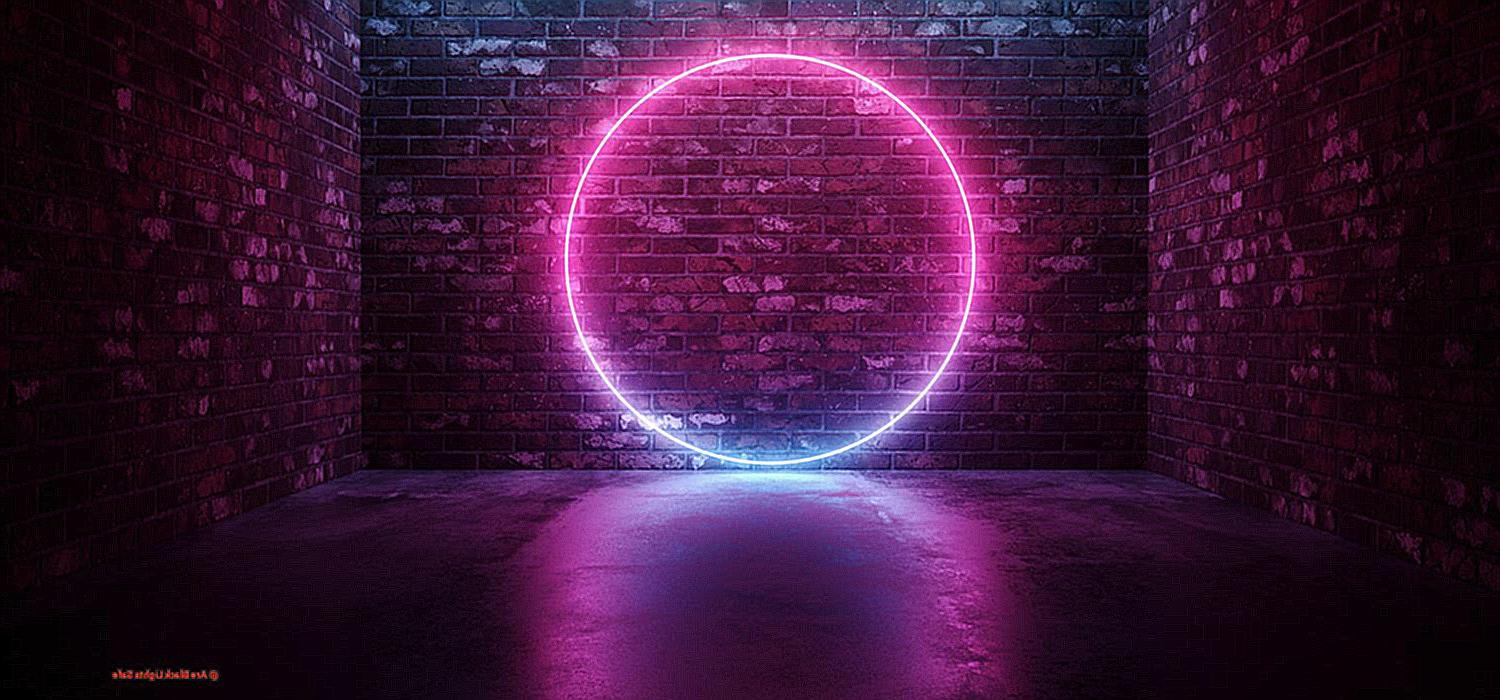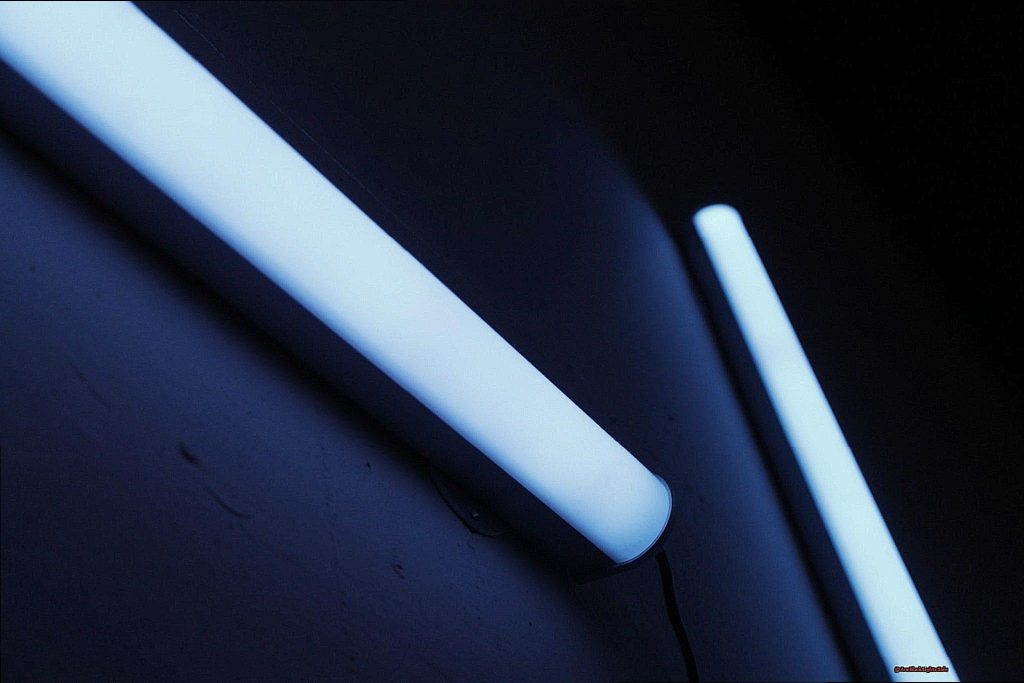Ready to learn all about the safety of black lights? You’ve come to the right place.
Black lights have been a staple in the entertainment world for years, adding a cool and mysterious vibe to any gathering. But with their growing popularity, it’s important to know the facts and dispel any rumors about their safety.
So, let’s dim the lights and get into it – everything you need to know about black light safety is just a scroll away.
Are Black Lights Safe?
Contents
These lights emit a type of light called ultraviolet (UV) light, which is invisible to the human eye and can cause certain materials to glow. While they may add a cool ambiance to your space, you may be wondering if they are safe for your furry companions.
In this comprehensive guide, we will explore the potential risks of using black lights around cats and provide tips on safely incorporating them into your home. So, before you turn on that black light, read on to understand the potential dangers and how to keep your furry friends safe.
What Are Black Lights?
Black lights, also known as UV lights, emit a type of light that is invisible to the human eye. They work by converting UV light into visible light through a process called fluorescence. This means that when certain materials come into contact with the UV rays, they can absorb and re-emit them as visible light, causing them to glow.
Why Are Black Lights Potentially Harmful?
UV light can be harmful to both humans and animals if exposed to it for an extended period. It can cause skin damage, including sunburns and increase the risk of developing skin cancer. Additionally, prolonged exposure to UV light can also cause eye damage, such as cataracts or corneal damage.
Are Black Lights Safe for Cats?
Unfortunately, there is limited research on the effects of black lights specifically on cats. However, we do know that cats are more sensitive to UV light than humans because they have less protective pigment in their eyes. This means that prolonged exposure to black lights can potentially cause eye damage, leading to vision problems or even blindness in severe cases.
Precautions When Using Black Lights Around Cats
If you have a black light in your home, it is essential to take precautions to protect your cat’s well-being. Here are some measures you can take:
- Keep Your Cat at a Safe Distance: It is recommended to keep your cat away from black lights or use protective eyewear for them if they cannot avoid being in the same room.
- Avoid Direct Exposure to Eyes: Never shine the black light directly into your cat’s eyes, as this can cause immediate damage.
The Different Types of Black Lights
Black lights are a fascinating and popular addition to any party or event. But what exactly are black lights, and how do they work? As a cat owner, it’s essential to know the different types of black lights and their potential risks when it comes to your furry friend’s safety.
So let’s dive into the world of black lights.
First things first, there are three main types of black lights: ultraviolet (UV) lights, LED black lights, and fluorescent black lights. Each type has its unique characteristics and uses, making them suitable for different situations.
Ultraviolet (UV) black lights emit UV-A light, which is not visible to the naked eye. These types of lights are commonly used in medical and forensic settings to detect bodily fluids, bacteria, and other substances that can’t be seen with the naked eye.
LED black lights, on the other hand, use light-emitting diodes to produce UV-A light. They are more energy-efficient than traditional UV lights and have a longer lifespan. LED black lights are often used for recreational purposes such as glow-in-the-dark parties and decorations.
Lastly, fluorescent black lights, also known as “blacklight blue” lights, emit a combination of visible and ultraviolet light. They are commonly used in nightclubs and concerts for their psychedelic effect on fluorescent or neon colors.
But as exciting as black lights may be, it’s crucial to be aware that not all black lights are created equal. Some cheap versions may not emit enough UV-A light to be effective, while others may have harmful levels of UV radiation.
This is where things get concerning for cat owners. UV-A light can be harmful to cats if they are exposed to it for too long. While LED and fluorescent black lights are generally considered safer for cats, it’s still essential to monitor their exposure to them.
Fluorescent black lights emit a wider spectrum of UV light compared to LED black lights, making them potentially more dangerous for pets. The wider spectrum can result in higher levels of harmful UV radiation, which can cause skin damage and even increase the risk of developing skin cancer.
On the other hand, LED black lights typically emit lower levels of UV radiation and are considered safer for pets. However, it is still essential to use caution when using any type of black light around pets, as prolonged exposure to even low levels of UV radiation can still be harmful.
To ensure your cat’s safety, it is recommended to use LED black lights specifically designed for pet safety and emit lower levels of UV radiation. Some manufacturers also offer filters or shields to further reduce the risk of UV exposure from fluorescent black lights.
Potential Risks of Black Lights for Cats
As cat owners, we want nothing but the best for our furry companions. We go above and beyond to ensure their safety and well-being, from carefully selecting their food to cat-proofing our homes. However, one potential danger that may often go unnoticed is the use of black lights around cats.
Black lights emit ultraviolet (UV) light, which can be harmful to both humans and animals if overexposed. Cats, in particular, are more susceptible to the dangers of UV light due to their unique vision capabilities. This makes it crucial for cat owners to understand the potential risks associated with black lights and take necessary precautions to protect their pets.
The main concern with black lights and cats is the potential for eye damage. Cats have a higher sensitivity to UV light than humans, meaning they can become easily overexposed and suffer from eye irritation or even permanent damage. This is especially dangerous for cats with pre-existing eye conditions, such as cataracts.
Furthermore, as natural hunters, cats may be attracted to the insects and small animals that are visible under black lights. This could lead to them ingesting harmful substances or becoming injured while trying to catch their prey. Ingesting any parts of a black light bulb or the liquid inside can also be dangerous for cats as these bulbs contain mercury, which is toxic to both humans and animals.
Moreover, the chemicals used in black light markers or paints can also be harmful if ingested by cats. These substances can cause digestive issues, vomiting, and even neurological damage. It is crucial for cat owners to keep an eye on their pets when using black lights and intervene if they show signs of discomfort or excessive interest in the light source.
Harmful Effects of Prolonged Exposure to UV Light on Cats

There may be certain household items that we overlook as potential hazards for our cats. One such item is the black light, which emits UV light that can be harmful to our feline friends if they are exposed to it for prolonged periods.
So why exactly is UV light dangerous for cats? Well, just like humans, cats can also experience negative effects from prolonged exposure to UV light. This includes skin damage such as sunburns and even skin cancer. Cats with lighter fur or skin are at a higher risk for these harmful effects due to their lack of natural protection against UV rays.
But it’s not just their skin that can be affected by black lights. The eyes of cats are also sensitive to UV light and can be damaged by prolonged exposure. This can lead to eye irritation, discomfort, and even blindness. And we all know how much our cats rely on their keen sense of sight, so it’s important to protect their eyes from any potential harm.
Furthermore, cats may also experience discomfort and irritation from the bright light emitted by black lights. This can cause them to avoid areas where these lights are used, disrupting their usual routines and behaviors. Additionally, kittens and older cats are more vulnerable to the harmful effects of UV light due to their weaker immune systems.
If your cat has pre-existing health conditions, such as immune disorders or skin allergies, they may be more susceptible to the harmful effects of UV light. It is crucial to monitor your cat’s exposure to black lights and limit it if necessary, especially for indoor cats who may spend a lot of time in close proximity to these lights.
If you do use black lights in your home for any reason, make sure to keep them out of reach of your cat and monitor their reactions closely. If you notice any signs of discomfort or irritation, seek veterinary care immediately.
How to Keep Your Cat Safe Around Black Lights
While these lights can create a fun and unique atmosphere, it’s essential to understand the potential risks they pose to our feline friends. As an expert on keeping cats safe around black lights, I have compiled research and relevant context to help you protect your furry companion. Here are some tips and precautions to keep your cat safe around black lights.
First and foremost, it’s essential to know that black lights emit ultraviolet (UV) light, which can be harmful to cats if they are exposed to it for extended periods. Unlike humans, cats have sensitive eyes that are not designed to filter out UV light. This can lead to eye problems such as cataracts, corneal ulcers, and retinal damage. Exposure to UV light can also cause skin irritation or burns in cats.
To keep your cat safe, it is crucial to limit their exposure to black lights. Avoid using them in areas where your cat spends a lot of time, such as their favorite napping spot. If you do use black lights in your home, make sure they are placed in an area that your cat cannot access, such as a high shelf or a room they cannot enter. Additionally, consider using alternative lighting sources such as LED black lights or fluorescent lights, which emit less UV light.
Another option is to use protective eyewear for your cat. Companies like Cat-Safe offer goggles specifically designed for cats that protect their eyes from UV light. If you are using black lights for entertainment purposes, make sure your cat is not in the room while it is on. And if your cat accidentally comes into contact with a black light, monitor them for any signs of discomfort or irritation.
It’s also crucial to note that not all black lights are created equal – some emit higher levels of UV light than others. When purchasing a black light, look for one that specifically states it is safe for pets or has a low UV emission level.
Precautions When Using Black Lights with Cats in the Home
While black lights can be entertaining and visually appealing, it is important to consider the safety of your furry friend, your beloved cat. As an expert on the topic of “Precautions When Using Black Lights with Cats in the Home,” I am here to provide valuable insights and tips for cat owners to ensure their cat’s well-being.
First and foremost, it is crucial to understand that black lights emit ultraviolet (UV) light, which can be harmful to cats if they are exposed to it for extended periods of time. The UV light can cause damage to their eyes and skin, leading to potential health issues. Therefore, it is essential to take precautions when using black lights in your home.
One precaution is to limit the amount of time your cat is exposed to the black light. It is recommended to only use the black light for short periods of time, no more than 10 minutes at a time. This will minimize their exposure and reduce the risk of any potential harm.
Another important precaution is to keep the black light out of reach of cats. As curious creatures, they may try to play with or chew on the light, potentially causing harm. It is best to keep the light in a secure location or use alternative lighting sources when your cat is around.
Additionally, proper ventilation is crucial when using a black light. Cats can be sensitive to strong smells and fumes, so make sure the room is well-ventilated before turning on the black light.
If you are using a handheld black light, be mindful of where you are shining it. It is important to use it in a well-lit area to avoid accidentally shining it directly into your cat’s eyes. This can cause discomfort or even damage to their eyesight.
Lastly, provide a safe and dark area for your cat to retreat if needed. If your cat shows any signs of discomfort or overstimulation, it is crucial to turn off the light and remove them from the area immediately. This will allow them to relax and feel safe in their own space.
Materials That May Glow Under Black Lights and Their Dangers for Cats
Firstly, let’s understand what materials may glow under black lights. Laundry detergents, cleaning products, and even certain types of cat urine are common substances that may fluoresce. These materials can contain chemicals such as bleach and phosphors, which can be toxic to cats if ingested or absorbed through their skin.
But wait, there’s more. Everyday objects like highlighters, glow sticks, and certain plants may also glow under black lights. While they may not necessarily be harmful to cats, it is best to keep them out of their reach to prevent any potential accidents.
So, what can you do to protect your cat from these dangers? Firstly, limit their exposure to materials that may fluoresce. Keep laundry detergents and cleaning products securely stored and regularly clean any areas that your cat may have come into contact with these substances.
Secondly, proper ventilation is crucial when using black lights in your home. Make sure there is enough fresh air circulation to prevent your cat from inhaling any harmful chemicals or fumes.
Thirdly, provide a safe retreat for your cat. Cats can be curious creatures, and they may try to explore or play with objects that glow under black lights. By creating a safe space for them with toys and distractions, you can prevent any potential accidents.
It is also worth noting that black lights themselves can pose a danger to cats. The UV light emitted by these lights can cause eye damage and skin irritation in both humans and animals. If you plan on using black lights in your home, make sure to keep them out of reach of your pets and never shine them directly into their eyes.
Conclusion
In summary, black lights have become a popular addition to parties and events, adding an alluring and enigmatic atmosphere. However, as their popularity rises, it is crucial to understand the facts and dispel any myths about their safety. This comprehensive guide has delved into the potential risks of using black lights around cats and provided valuable tips on incorporating them into your home safely.
Black lights emit ultraviolet (UV) light, which can be harmful to both humans and animals if exposed for prolonged periods. Cats are particularly susceptible due to their delicate eyes and weaker immune systems. Extended exposure to UV light can result in eye damage, skin irritation or burns, and even increase the risk of developing skin cancer.
To ensure your cat’s safety around black lights, it is essential to limit their exposure, keep the lights out of reach, provide adequate ventilation, and create a safe haven for them if needed. Additionally, be mindful of materials that may glow under black lights, such as cleaning products or certain plants that could contain harmful chemicals.
Always prioritize your cat’s well-being when using black lights in your home. With these precautions in mind, you can still bask in the captivating ambiance of black lights while keeping your furry companion safe.






